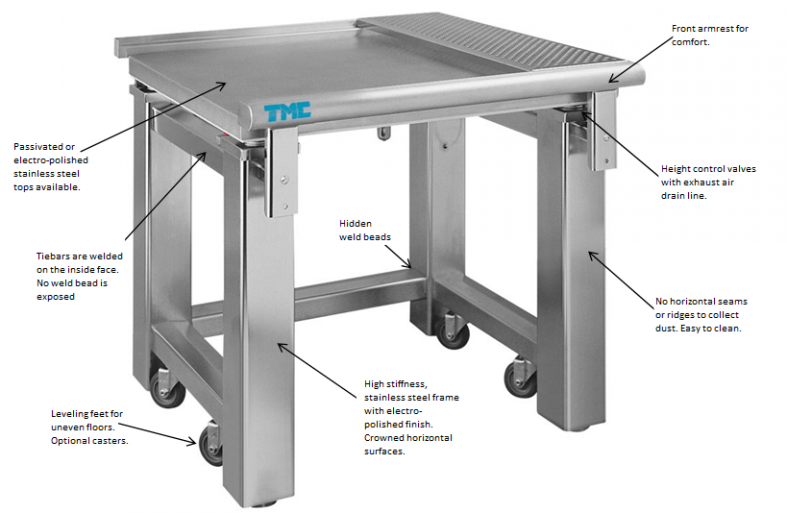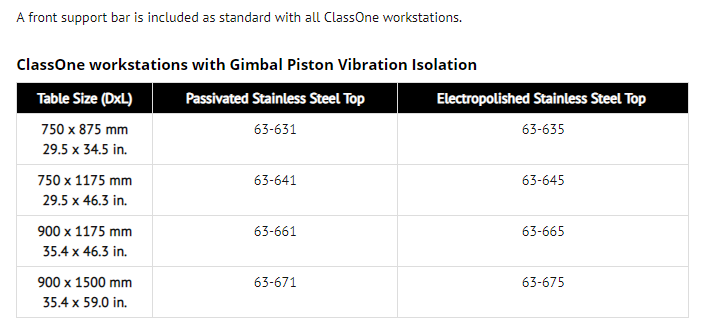Description
TMC ClassOne 63-600 Vibration Isolation Cleanroom Table
The all-stainless steel TMC ClassOne™ Workstation is a high-performance, pneumatic vibration isolation table designed from the floor up for maximum cleanroom compatibility. The same Gimbal Piston™ element provides isolation, which offers unsurpassed performance in isolating optical tables, electron microscopes, precision balances, and scanning tunneling microscopes.
The ClassOne Workstation is alcohol-wiped with a lint-free cloth and is double-wrapped in plastic at the factory before shipping.

All CleanBench tables incorporate TMC’s Gimbal Piston Air Isolators as a standard feature. The Gimbal Piston has consistently outperformed other air isolators in side-by-side testing. It offers outstanding low-frequency vibration isolation in all axes and maintains its performance specifications even when subjected to deficient input levels of excitation. Proprietary damping techniques allow the Gimbal Piston to stabilize relatively top-heavy payloads and quickly dissipate disturbances of the isolated table top.

Benefits:
- Vertical and horizontal vibration isolation starting at 2 Hz
- Reduces vibration by more than 95% at 10Hz
- Virtually free of friction, avoiding rolling friction to static friction transitions
- Accommodates horizontal displacement by acting as a gimbal
The Gimbal Piston® Air Isolator provides outstanding isolation in all directions for even the lowest input levels. It is lightly damped and highly responsive to typical, low-amplitude ambient floor vibrations. It achieves very high damping for gross transient disturbances, such as sudden load changes or bumping of the top plate. The result is that Gimbal Piston Isolators provide superior isolation yet will virtually eliminate any gross disturbance within a few seconds. It can also stabilize isolated systems with relatively high centers of gravity without compromising isolation.
Low-Amplitude Input Response

The greatest challenge in designing an effective isolator is maintaining good performance at the low vibration amplitude inputs typical of ambient building floor vibration. Isolator specifications are often based on measurements done with the isolator placed on a “shaker table” with very high amplitude input levels. Such testing, with input amplitudes on the order of millimeters, yields unrealistic performance expectations and is misleading as results will not reflect the actual performance.
The Gimbal Piston Isolator design uniquely maintains its stated resonant frequency and high attenuation level in even quiet, natural floor environments. The performance is linear to such low amplitudes because the design is virtually free of friction and, therefore, can avoid rolling friction to static friction transitions.
Every other system we have tested at levels typical for floor vibration exhibits a higher resonant frequency than claimed or a substantial increase in transmission through the isolator mount.
We stress the importance of performance specifications at low levels because we have repeatedly observed, in our testing and many as-used installations, that better performance is much easier to achieve at greater amplitudes and higher frequencies.

Horizontal vs. Vertical Inputs:
Our innovative Isolator allows a thin-wall, rolling diaphragm seal to accommodate horizontal displacement by acting as a gimbal. Instead of using a cable-type pendulum suspension, the Gimbal Piston Isolator carries the load on a separate top plate with a rigid rod extending into a well in the main piston. The bottom of the rod has a ball-end that bears on a hard, flat seat. An inherently flexible coupling allows horizontal flexure in the isolator as the ball simply rocks (without sliding or rolling) very slightly on the seat. The approach works exceptionally well, even with sub-microinch levels of input displacement, because the static friction is virtually the same as the rolling friction. Horizontal motion is converted to the usual vertical diaphragm flexure but out of phase: one side of the piston up, the other down, in a gimbal-like motion.
















